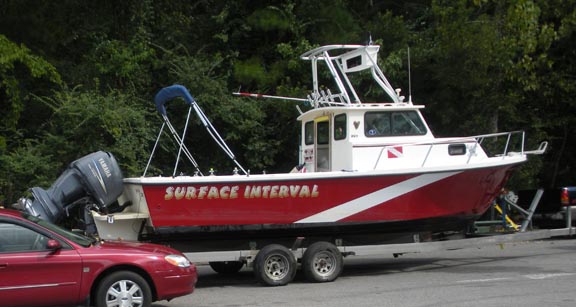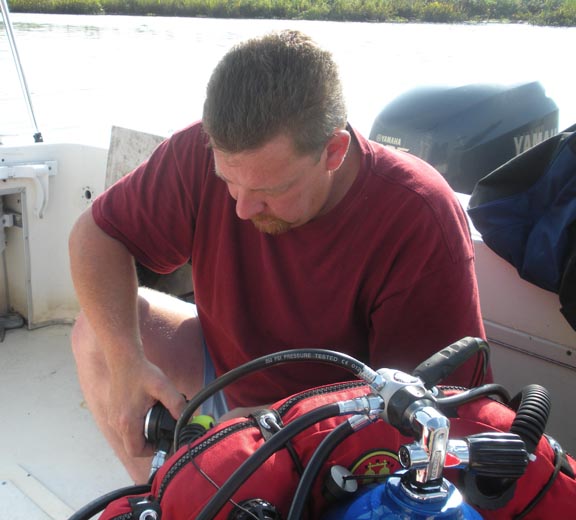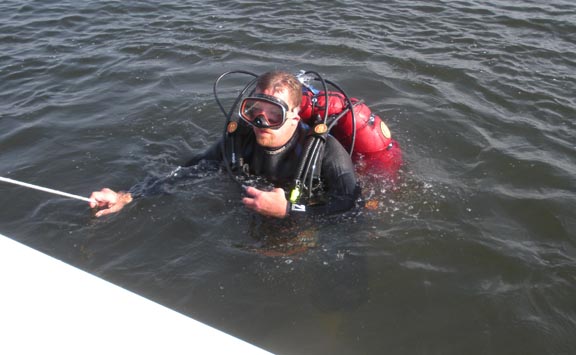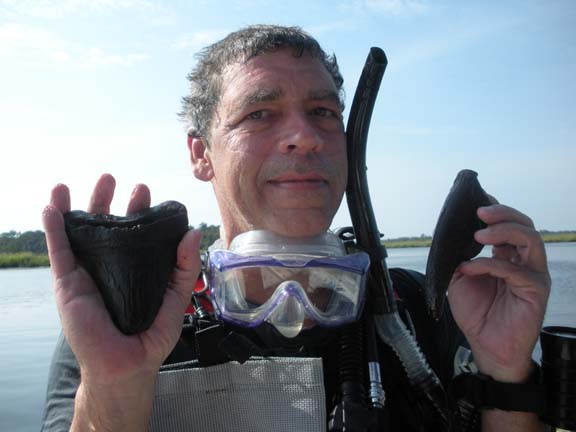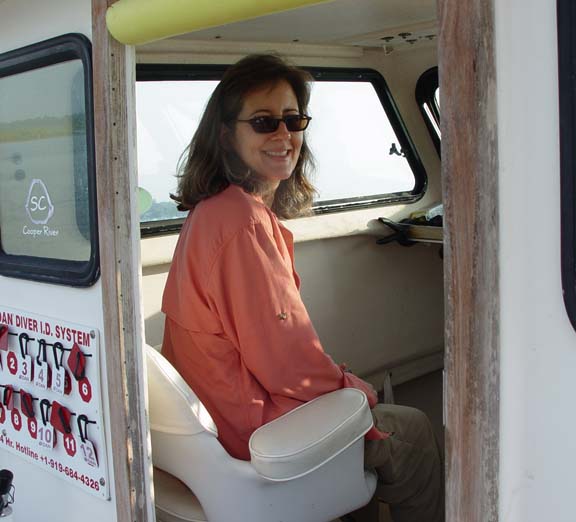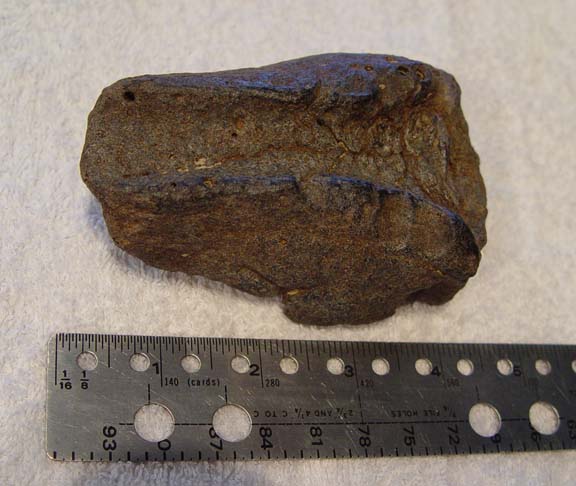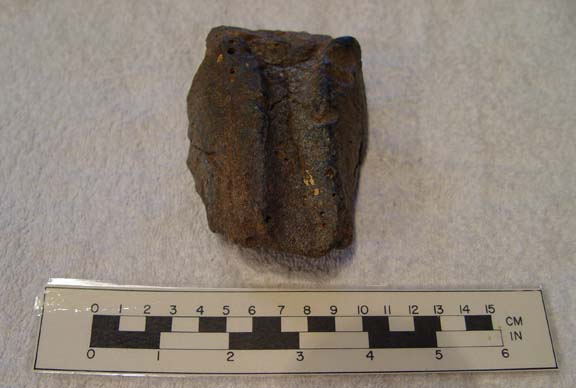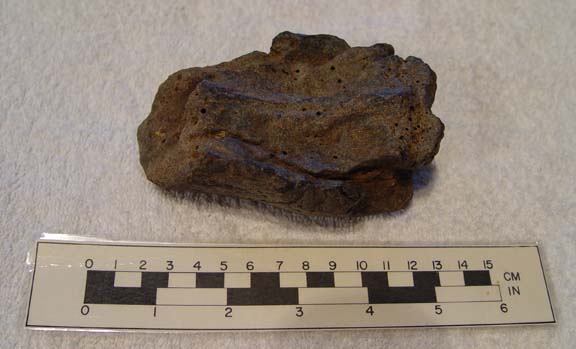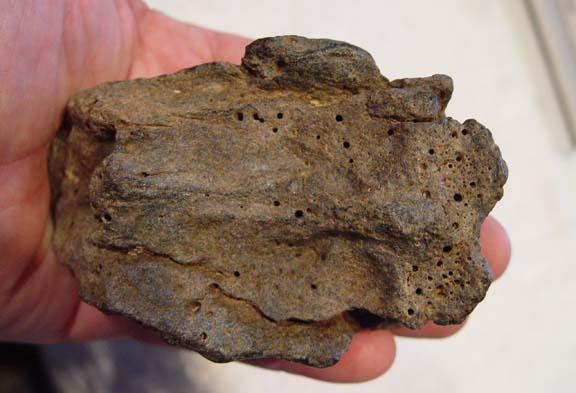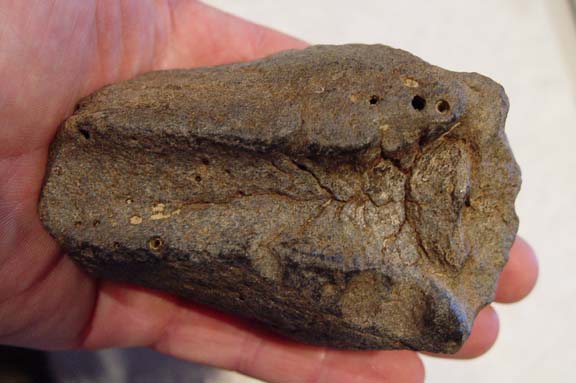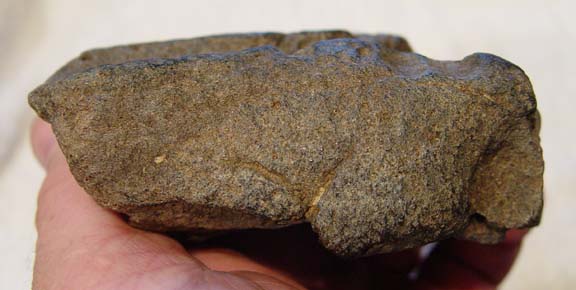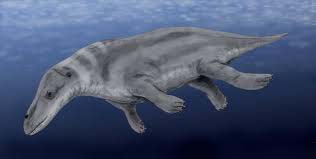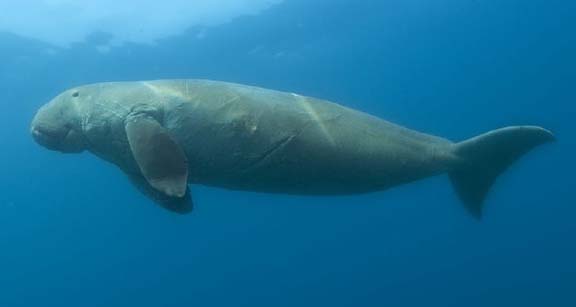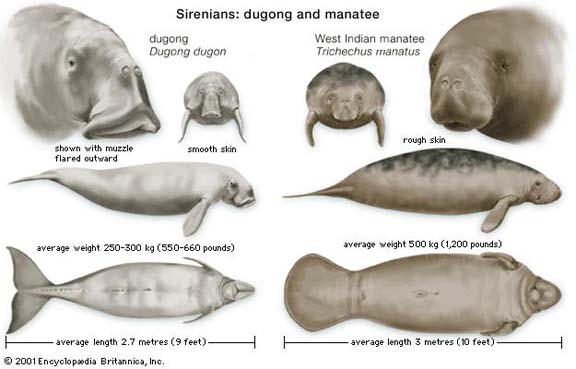New Species Photos by: Rick Jacquot This report is to document a new species that I found in 2009, while diving the Cooper River in South Carolina. In September, 2009, I was on a ten day dive safari with Sandy. The first part of our trip was a couple of days diving the Cooper River with Charter Captain Johnny Cercopely and his boat the "Surface Interval". We also had our friend, Robert Kyle, diving with us.
We headed out the first day to a dive site just below the "T" in the Cooper River. This site has been visited many times by divers but there is always a lot of material to be found.
Captain Johnny at the helm.
Getting geared up.
Ready to splash.
Back to the surface with a bag of goodies. I didn't know what I had found at the time. I assumed I had some nice shark teeth and odd bones as usual. I always pick up any weird looking bones I see, not just the shark teeth.
My friend Robert went home happy from the Cooper, with a nice meg tooth and an awesome sloth claw!
Sandy cruising in the cabin of the Surface Interval. We spent the next several days on our trip. We visited Jekyll Island, Venice Beach and a few other sites before heading back home to North Carolina. The entire time I was on the trip, I kept looking at the one odd fossil I had collected in the Cooper. It was different then any other skullcap I had found. It looked similar to a dugong skullcap, but just a little different. Once home, I took numerous pictures and emailed them to Dr. Richard Hulbert at the University of Florida. He agreed it was some type of sirenian skullcap, but could not positively identify it. He suggested I contact Dr. Daryl Domning in Washington D.C. as he is an expert on sirenian fossils.
Skullcap of Protosirenid Sirenian, top.
Skullcap of Protosirenid Sirenian, top right side.
Skullcap of Protosirenid Sirenian, top rear view.
Skullcap of Protosirenid Sirenian, top front view.
Skullcap of Protosirenid Sirenian, bottom.
Skullcap of Protosirenid Sirenian, bottom, close up.
Skullcap of Protosirenid Sirenian, top, close up.
Skullcap of Protosirenid Sirenian, right side, close up.
Skullcap of Protosirenid Sirenian, left side, close up.
Skullcap of Protosirenid Sirenian, rear, close up.
Skullcap of Protosirenid Sirenian, bottom rear, close up. After sending the photos to Dr. Domning, he sent me the following; "Dear Rick, Please let me know if I can provide any other information; but as far as the identity of your beast goes, that’s about as much as can be said now. I hope you can turn up more of this species! Sincerely, After learning this, I contracted to have some casts made of the specimen for further study by various museums. I sent casts to the University of Florida, South Carolina State Museum and the Smithsonian in Washington. After sending a cast of the specimen to Washington for further study by Dr. Domning, I learned more about the specimen; "Thank you very much for the fine cast of the sirenian skullcap from the Cooper River, South Carolina. I will convey it to the National Museum of Natural History, Smithsonian Institution, for inclusion in their permanent collection of fossil vertebrates. Your donation of this significant specimen is a much-appreciated addition to our knowledge of the sirenian fossil record. The specimen is the parietal-supraoccipital skullcap of what is most likely a protosirenid sirenian, presumably Eocene in age. It most nearly resembles the skullcaps from the Middle Eocene Avon Park Limestone, exposed in the Waccasassa River and other localities in northwestern peninsular Florida. These were described by Domning, Morgan, and Ray (Smithsonian Contributions to Paleobiology No. 52, 1982) as “Protosiren sp.”, though now I believe they represent a different and new genus of protosirenid. Your specimen differs from the Florida skullcaps in having prominently upraised temporal crests, and indentations on the posterolateral surfaces (for the squamosal bones) that end well below the tops of the temporal crests. It is likely to represent a new genus and species of protosirenid." I later sent the original fossil to the Smithsonian for more study and kept a cast for my collection. This specimen is from the Eocene epoch 56-34 million years ago. This newly discovered species of sirenian is a distant relative of the Dugong and Manatee. These creatures started off as four legged animals that roamed on land. The evolution process went from the four legged land animal (Paleocene to early Eocene epoch) Once they moved into the water, the front and rear limbs began to evolve into flippers sometime during the Eocene epoch.
Eocene Proto Sirenian Between the Eocene and Pleistocene epochs, the rear limbs disappeared leaving only two front flippers and a tail fin (Pleistocene Dugong species) A branch of Dugong's eventually evolved into today's Dugong's and Manatees.
I will always pick up any odd looking bone when hunting for fossils, whether diving or land hunting. You never know when the next link in the chain of evolution is in your goodie bag! The Smithsonian, South Carolina State Museum and University of Florida have casts of the skullcap for their permanent collections. |
